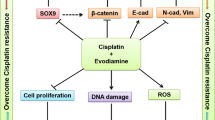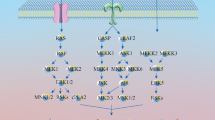Abstract
Myrislignan is a natural compound with little pharmacological study. In our investigation, we investigated the effect of myrislignan in the induction of apoptosis in A549 cells in vitro and in vivo. Myrislignan inhibited the proliferation of A549 cells in a dose- and time-dependent manner assayed by MTT. In addition, Hoechst flow cytometry showed that myrislignan significantly induced apoptosis and cell cycle arrest in A549 cells. The apoptosis and anti-cell proliferation was mediated by the activation of mitogen-activated protein kinase and the inhibition of epidermal growth factor receptor signal pathway, change of mitochondrial membrane potential, the releasing of c-Myc, the downregulation of the level of the anti-apoptotic protein Bcl-2, and the upregulation of the level of the pro-apoptotic protein Bax. In conclusion, those results reveal a potential mechanism for the anti-cancer effect of myrislignan on human lung cancer, while suggesting that myrislignan may be a promising compound for the treatment of lung cancer.



Similar content being viewed by others
References
Wang Y, Sun Y (2015) Clinical experiences with molecular targeted therapy in lung cancer in China. Thorac Cancer 6(4):379–384
Johnson DH, Schiller JH, Bunn PA Jr (2014) Recent clinical advances in lung cancer management. J Clin Oncol 32(10):973–982
DeSantis C, Naishadham D, Jemal A (2013) Cancer statistics for African Americans, 2013. CA Cancer J Clin 63(3):151–166
Spira A, Halmos B, Powell CA (2015) Update in lung cancer 2014. Am J Respir Crit Care Med 192(3):283–294
Sundar R, Soong R, Cho BC, Brahmer JR, Soo RA (2014) Immunotherapy in the treatment of non-small cell lung cancer. Lung Cancer 85(2):101–109
Byers LA, Rudin CM (2015) Small cell lung cancer: where do we go from here? Cancer 121(5):664–672
Suda K, Sato K, Mizuuchi H, Kobayashi Y, Shimoji M, Tomizawa K, Takemoto T, Iwasaki T, Sakaguchi M, Mitsudomi T (2014) Recent evidence, advances, and current practices in surgical treatment of lung cancer. Respir Investig 52(6):322–329
Badr CE, Van Hoppe S, Dumbuya H, Tjon-Kon-Fat LA, Tannous BA (2013) Targeting cancer cells with the natural compound obtusaquinone. J Natl Cancer Inst 105(9):643–653
Yang XW, Huang X, Ahmat M (2008) New neolignan from seed of Myristica fragrans. Zhongguo Zhong Yao Za Zhi 33(4):397–402
Li F, Yang XW (2008) Quantification of myrislignan in rat plasma by solid-phase extraction and reversed-phase high-performance liquid chromatography. Biomed Chromatogr 22(6):601–605
Du SS, Yang K, Wang CF, You CX, Geng ZF, Guo SS, Deng ZW, Liu ZL (2014) Chemical constituents and activities of the essential oil from Myristica fragrans against cigarette beetle Lasioderma serricorne. Chem Biodivers 11(9):1449–1456
Cao GY, Xu W, Yang XW, Gonzalez FJ, Li F (2015) New neolignans from the seeds of Myristica fragrans that inhibit nitric oxide production. Food Chem 173:231–237
Li F, Yang XW (2008) Biotransformation of myrislignan by rat liver microsomes in vitro. Phytochemistry 69(3):765–771
Jin H, Zhu ZG, Yu PJ, Wang GF, Zhang JY, Li JR, Ai RT, Li ZH, Tian YX, Zhang WX, Wu SG (2012) Myrislignan attenuates lipopolysaccharide-induced inflammation reaction in murine macrophage cells through inhibition of NF-kappaB signalling pathway activation. Phytother Res 26(9):1320–1326
Yang XW, Huang X, Ma L, Wu Q, Xu W (2010) The intestinal permeability of neolignans from the seeds of Myristica fragrans in the Caco-2 cell monolayer model. Planta Med 76(14):1587–1591
Wang Y, Liu JX, Zhang YB, Li F, Yang XW (2012) Determination and distribution study of myrislignan in rat tissues by RP-HPLC. Chromatographia 75:541–549
Chen Z, Huang X, Yang H, Ding W, Gao L, Ye Z, Zhang Y, Yu Y, Lou Y (2011) Anti-tumor effects of B-2, a novel 2,3-disubstituted 8-arylamino-3H-imidazo[4,5-g]quinazoline derivative, on the human lung adenocarcinoma A549 cell line in vitro and in vivo. Chem Biol Interact 189(1–2):90–99
Estaquier J, Vallette F, Vayssiere JL, Mignotte B (2012) The mitochondrial pathways of apoptosis. Adv Exp Med Biol 942:157–183
Morabito A, Carillio G, Daniele G, Piccirillo MC, Montanino A, Costanzo R, Sandomenico C, Giordano P, Normanno N, Perrone F, Rocco G, Di Maio M (2014) Treatment of small cell lung cancer. Crit Rev Oncol Hematol 91(3):257–270
Chaveli-López B (2014) Oral toxicity produced by chemotherapy: a systematic review. J Clin Exp Dent 6(1):e81–e90
Tan W, Lu J, Huang M, Li Y, Chen M, Wu G, Gong J, Zhong Z, Xu Z, Dang Y, Guo J, Chen X, Wang Y (2011) Anti-cancer natural products isolated from Chinese medicinal herbs. Chin Med 6(1):27
Himeji M, Ohtsuki T, Fukazawa H, Tanaka M, Yazaki S, Ui S, Nishio K, Yamamoto H, Tasaka K, Mimura A (2007) Difference of growth-inhibitory effect of Scutellaria baicalensis-producing flavonoid wogonin among human cancer cells and normal diploid cell. Cancer Lett 245(1–2):269–274
Griffin C, Karnik A, McNulty J, Pandey S (2011) Pancratistatin selectively targets cancer cell mitochondria and reduces growth of human colon tumor xenografts. Mol Cancer Ther 10(1):57–68
Kalemkerian GP (2014) Advances in pharmacotherapy of small cell lung cancer. Expert Opin Pharmacother 15(16):2385–2396
Giard DJ, Aaronson SA, Todaro GJ, Arnstein P, Kersey JH, Dosik H, Parks WP (1973) In vitro cultivation of human tumors: establishment of cell lines derived from a series of solid tumors. J Natl Cancer Inst 51(5):1417–1423
Lurje G, Lenz HJ (2009) EGFR signaling and drug discovery. Oncology 77(6):400–410
Uribe P, Gonzalez S (2011) Epidermal growth factor receptor (EGFR) and squamous cell carcinoma of the skin: molecular bases for EGFR-targeted therapy. Pathol Res Pract 207(6):337–342
Bai Y, Yu W, Han N, Yang F, Sun Y, Zhang L, Zhao M, Huang L, Zhou A, Wang F, Li X (2013) Effects of semaphorin 3A on retinal pigment epithelial cell activity. Invest Ophthalmol Vis Sci 54(10):6628–6638
Kuroda S, Tam J, Roth JA, Sokolov K, Ramesh R (2014) EGFR-targeted plasmonic magnetic nanoparticles suppress lung tumor growth by abrogating G2/M cell-cycle arrest and inducing DNA damage. Int J Nanomed 9:3825–3839
Lee H, Lee H, Chin H, Kim K, Lee D (2014) ERBB3 knockdown induces cell cycle arrest and activation of Bak and Bax-dependent apoptosis in colon cancer cells. Oncotarget 5(13):5138–5152
Kobayashi S, Boggon TJ, Dayaram T, Jänne PA, Kocher O, Meyerson M, Johnson BE, Eck MJ, Tenen DG, Halmos B (2005) EGFR mutation and resistance of non-small-cell lung cancer to gefitinib. N Engl J Med 352(8):786–792
Huguet F, Fernet M, Giocanti N, Favaudon V, Larsen AK (2016) Afatinib, an irreversible EGFR family inhibitor, shows activity toward pancreatic cancer cells, alone and in combination with radiotherapy, independent of KRAS status. Target Oncol 11(3):371–381
Zheng YT, Yang HY, Li T, Zhao B, Shao TF, Xiang XQ, Cai WM (2015) Amiloride sensitizes human pancreatic cancer cells to erlotinib in vitro through inhibition of the PI3K/AKT signaling pathway. Acta Pharmacol Sin 36(5):614–626
Normanno N, Campiglio M, Maiello MR, De Luca A, Mancino M, Gallo M, D’Alessio A, Menard S (2008) Breast cancer cells with acquired resistance to the EGFR tyrosine kinase inhibitor gefitinib show persistent activation of MAPK signaling. Breast Cancer Res Treat 112(1):25–33
Dhillon AS, Hagan S, Rath O, Kolch W (2007) MAP kinase signalling pathways in cancer. Oncogene 26(22):3279–3290
Burova EB, Smirnova IS, Gonchar IV, Shatrova AN, Nikolsky NN (2011) Inhibition of the EGF receptor and ERK1/2 signaling pathways rescues the human epidermoid carcinoma A431 cells from IFNgamma-induced apoptosis. Cell Cycle 10(13):2197–2205
Xu T, Wang NS, Fu LL, Ye CY, Yu SQ, Mei CL (2012) Celecoxib inhibits growth of human autosomal dominant polycystic kidney cyst-lining epithelial cells through the VEGF/Raf/MAPK/ERK signaling pathway. Mol Biol Rep 39(7):7743–7753
Zhang XJ, Zhang L, Liu YP, Xu HM, Sun P, Song JG, Luo YH (2013) Molecular mechanism of chemosensitization to paclitaxel in human melanoma cells induced by targeting the EGFR signaling pathway. Zhonghua Zhong Liu Za Zhi 35(3):181–186
Jiang Y, Zhang Y, Luan J, Duan H, Zhang F, Yagasaki K, Zhang G (2010) Effects of bufalin on the proliferation of human lung cancer cells and its molecular mechanisms of action. Cytotechnology 62(6):573–583
Ashkenazi A, Salvesen G (2014) Regulated cell death: signaling and mechanisms. Annu Rev Cell Dev Biol 30:337–356
Green DR, Llambi F (2015) Cell death signaling. Cold Spring Harb Perspect Biol 7(12). pii: a006080
Li L, Gao Y, Zhang L, Zeng J, He D, Sun Y (2008) Silibinin inhibits cell growth and induces apoptosis by caspase activation, down-regulating survivin and blocking EGFR-ERK activation in renal cell carcinoma. Cancer Lett 272(1):61–69
Acknowledgments
Financial support for this research was provided by State Administration of Traditional Chinese Medicine “Twelfth Five Year Plan” Key Specialty (Chinese Medicine Geriatrics). Technological support for this research was provided by Shanghai Key Laboratory of Clinical Geriatric Medicine.
Author information
Authors and Affiliations
Corresponding author
Ethics declarations
Conflict of interest
No potential conflicts of interest were disclosed.
Additional information
X. Lu and L. Yang contributed to this work equally.
Electronic supplementary material
Below is the link to the electronic supplementary material.
11418_2016_1029_MOESM1_ESM.tif
Supplementary Fig. 1. Myrislignan induced apoptosis and cell cycle arrest in A549 cells. Flow cytometry assay was used to determine the apoptosis of A549 cells with increasing concentrations of myrislignan or combined with EGF (100 ng/ml) for 48 h. a Annexin-V/PI assay. b Cell cycle assay. Statistical differences were considered significant at the levels of *p < 0.05, **p < 0.01, or ***p < 0.001
Rights and permissions
About this article
Cite this article
Lu, X., Yang, L., Chen, J. et al. The action and mechanism of myrislignan on A549 cells in vitro and in vivo. J Nat Med 71, 76–85 (2017). https://doi.org/10.1007/s11418-016-1029-6
Received:
Accepted:
Published:
Issue Date:
DOI: https://doi.org/10.1007/s11418-016-1029-6




